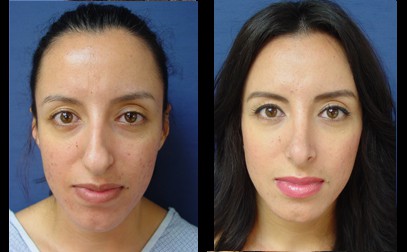
After your nose job (rhinoplasty) procedure, swelling of the nose and face is normal and can initially make your nose appear larger. For the first two weeks post-op, the swelling will be quite noticeable. But after the second week, swelling usually subsides and becomes much less obvious. However, the nose can still look a bit “puffy” for several months. By four months post-op, the majority of swelling should dissipate, but it can actually take a full year for all of the swellings to subside allowing you to see the final, true result of your nose job.
Supratip Swelling After Rhinoplasty
Fullness or a bulbous appearance, specifically, of the nasal tip following the rhinoplasty surgery is a complication that can be very disappointing. Fullness over the nose tip is termed “supratip fullness” and can cause the tip of your nose to look like it is drooping, much like a parrot’s beak. The first Dr. Laguna checks are that your surgeon did, in fact, place your nose tip in the proper position.
Proper Positioning of the Nasal Tip During Rhinoplasty

An aesthetically pleasing nose tip should be positioned to lead the dorsum (the external ridge of the nose) by about 1 to 2 mm. Tip support must be appropriately provided so that it maintains its position. An adequately positioned nasal tip resulting from a rhinoplasty that continues to appear droopy well after swelling has subsided due to fullness above the tip is classified as supratip fullness complication. Several factors can lead to this problem, thereby compromising the ideal aesthetic of your nose.

Under resection of the septum just behind the tip
The septum is the wall between your nostrils and acts as the primary central pillar support to the nose. Often, during the rhinoplasty procedure, areas in the septum are removed to eliminate any deviation affecting your breathing. Despite removing septal cartilage, experts must preserve a good amount of septum to maintain the infrastructure support of the nose. This is especially important in the front of the nose, where the nasal tip is often supported on the most projected portion, called the anterior septum. Yet, an area just behind this region needs to be lowered, or it will remain prominent and lead to the supra tip deformity.
Soft tissue fat of the nasal skin
Often nasal skin is fatty, and if not addressed, this fat can blunt the shape of the nasal tip despite surgical maneuvers to refine it. In addition, this fat can fill the area behind the tip resulting in supratip fullness. Ensuring a well-defined nasal tip requires proper defatting of the supratip region during the rhinoplasty procedure.
Memory of the skin shell
The skin of the supratip region often stiffens to a fuller convex-shaped shell over decades of life. Despite removing the underlying structures that have created a fuller supratip region, the skin might not accommodate the new shape. Such cases may require light scoring of the under-surface of the skin. Additionally, during the rhinoplasty procedure, a small internal stitch may assist in pulling the supratip skin down to its newly designed contour. Finally, aggressive taping and an external splint further assist in reforming the shape of the supratip skin shell.
Dr. Laguna is a highly-skilled, experienced rhinoplasty surgeon at the Cosmetic Plastic Surgery Institute. Book a free consultation today to determine whether you could benefit from a Revision Rhinoplasty.
SEE ALSO: The non-surgical Rhinoplasty
